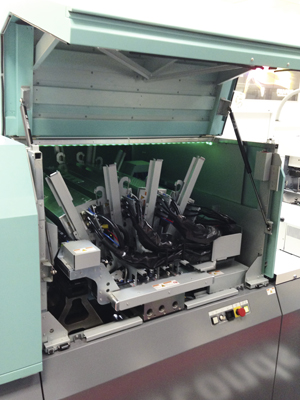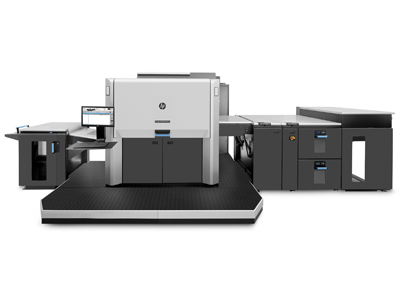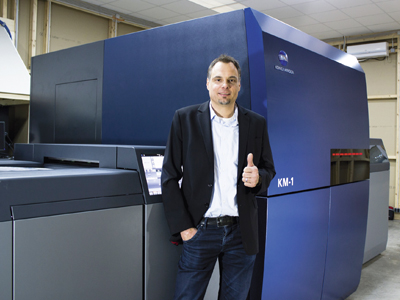Arndt Eschenlohr, president of PLS, with the AccurioJet KM-1
There are now several B2 sheet-fed digital presses available. Are we seeing a trend towards bigger formats or new applications, asks Nessan Cleary.
Historically, toner-based print engines have been limited to SRA3 because of the practical difficulties of building a wider imaging system. It’s always been easier to make these systems faster rather than wider to satisfy the demand for greater productivity. However, with inkjet it’s relatively easy to make a printbar for considerably greater widths. The difficulty is maintaining a constant distance between the nozzles and the substrate. This is much easier with a roll-fed machine, where the tension of the web can be used to control the media relative to the heads.
So not surprisingly there are quite a few B2 roll-fed printers around. Initially, these were mainly used to replace multiple digital toner printers for applications such as low-end direct mail and book printing, though recently we have seen web presses, such as Canon’s ProStream and the Xerox Trivor, that offer higher resolution and can handle offset stocks.
But commercial printers have always been more interested in sheet-fed presses for day-to-day work because it’s easier to load the appropriate stock. Several vendors have overcome the difficulty of developing a sheet-fed handling system suitable for inkjet and so a growing number of commercial printers are installing sheet-fed digital B2 presses. The reasons are mainly to do with run lengths and the improved margins from using standard litho stocks but they also offer the possibility of new applications, notably in packaging. These presses are often replacing offset rather than smaller format digital presses.
Take, for example, Fujifilm’s Jet Press 720S, a four-colour CMYK press that produces 2700 sheets per hour with full variable data. The most noticeable aspect of the Jet Press is that it only prints on one side of the sheet. However, it prints a barcode on every sheet so that they can be turned over and fed back into the stacker with the barcode ensuring that the correct image is printed on each side.
Mark Stephenson, Fujifilm’s product manager for digital presses, says that in the beginning it was seen as a niche product but that it is now gaining interest from general B2 users, noting: ‘People with a B2 press are used to turning the sheet over so it’s not a big thing for them. [The Jet Press] is tending to find traction in litho printers who want to do short run; the majority are printing on litho stocks.’
There are over 80 installed worldwide with several in the UK, including one at Kingfisher Press, based in Bury St Edmunds. Jon Doidge, a co-director at Kingfisher Press, says the company picked it to cope with short runs and to have the option to offer personalisation, explaining: ‘It’s not just an extra piece of kit, it’s a gateway to a whole new revenue stream for us, both with existing customers and new ones. We’ll send a lot of our short-run litho work there – freeing up space to do more longer runs on those presses – and at the same time we’ll be able to pitch for new customers we couldn’t have approached in the past.’

Fujifilm’s Jet Press 720S uses the Samba printheads and offers a wide colour gamut on most stocks
The Jet Press 720S uses the highly regarded Samba printheads from Fujifilm’s Dimatix subsidiary. These are four-level greyscale heads that boast 2048 nozzles and can achieve 1200 x 1200dpi resolution. The inks are Fujifilm’s own water-based Vividia inks and the press uses a primer, which enables it to print on most standard offset coated papers and on some uncoated stocks. The prints are dry as soon as they leave the press.
Mr Stephenson says that several customers also use the Jet Press for packaging, where the B2 format is useful. Fujifilm had originally toyed with developing a separate version for the packaging market but Stephenson says the 720S can serve both markets, explaining: ‘We can configure it for lighter stock up to 400gsm or for heavier stocks up to 650gsm so it does depend on the customer need.’
UV alternative
Konica Minolta has worked with Komori to develop another B2 sheet-fed press, which both sell under different names. Konica Minolta developed the imaging system and sells the press as the AccurioJet KM-1. Komori, which provided the media transport, calls its version the IS29 Impremia, though the two machines are fundamentally the same.
The KM-1/Impremia uses Konica Minolta printheads, giving it 1200 x 1200dpi resolution. Unlike most of the inkjet presses, it uses UV-curable inks, which means that it can print to a wide range of media without having to worry about drying. It can handle media up to 0.6mm thick as well as folding carton. The ink has a degree of elasticity that allows it to print to textured stocks. Mark Hinder, head of market development for Konica Minolta Europe, says that a lot of printers are looking to match offset print quality and to use their standard offset stocks, which the KM-1 can handle without the need for any pre-treatment.
So far Konica Minolta has installed two of these presses, with Hinder saying that others have been ordered and are awaiting delivery. The first of these went to Print Logistic Services (PLS), based in Markkleeburg, Germany, which is an online printer with a lot of short-run fast turnaround work. Hinder says, ‘They choose it for the format and the size and matching offset and for short runs which are typical for online.’ He adds, ‘They are going for a litho substrate for cost where digital has struggled.’
Arndt Eschenlohr, president of PLS, says that the technology is better than offset printing, adding, ‘One of the added benefits is that wastage is kept to a minimum. The AccurioJet KM-1 has enabled us to move into new markets, such as packaging, which we are confident will be a major growth area for digital printing.’
Konica Minolta installed its second KM-1 at Rehms Druck, in Borken, Germany earlier this year. Mr Hinder says that Rehms Druck bought the machine for high quality direct mail to cope with shorter run lengths and because they were struggling with rub-off. However, he adds that they are also printing onto plastic and foils, which most digital presses can’t handle. Daniel Baier, managing director of Rehms Druck, elaborates, ‘The performance and return on investment that the AccurioJet KM-1 can deliver will allow us to expand our market capability as we move into the packaging market and continue to develop our direct mail capabilities.’
True duplex
Screen still sells the Truepress JetSX, though only a handful have been installed in Europe. It’s an inkjet press using Epson greyscale printheads with water-based inks. It has a reasonably high 1400dpi resolution with a tiny two picolitre minimum dot size.
The sheets are printed on one side, and then fed back through the press for duplex printing. This gives it a compact size but halves its productivity from 1620 simplex sheets to 810 duplex sheets per hour. However, it can handle standard offset stocks, both coated and uncoated, as well as folding carton up to 600 microns thick.
Carlo Sammarco, Screen’s sales director for packaging solutions, says that it’s mainly used for the gifting market, explaining: ‘You can produce boxes for bespoke uses like marketing or advent calendars with a countdown to an event.’ He adds: ‘You can use pre die cut materials and print the variable data as the orders come in so there’s no finishing process actually required.’

This HP Indigo 12000 is a B2 liquid toner press. It is able to produce 4600 B2 sheets per hour using CMY only or 1725 duplex B2 sheets using CMYK
HP has also developed a B2-sized series of Indigo presses, starting with the Indigo 10000, which has now been superseded by the 12000. It uses the standard Indigo liquid toner print engine, which HP claims can deliver resolution equivalent to 2438 dpi. It typically prints CMYK though can support up to seven colours, which can include spots or an IndiChrome wide gamut inkset that adds orange, violet and green. It can produce 3450 single-sided sheets per hour, and half that double-sided. However, because the Indigo engine lays the colour down one at a time, it slows down with additional colours. There is an Enhanced Productivity Mode that prints 4600 single sided sheets per hour using just CMY with reasonably good results. It can take coated and uncoated media up to 400gsm.
One of these has gone to Onlineprinters, based in Neustadt an der Aisch, Germany. Michael Fries, CEO of Onlineprinters, explained, ‘We purchased the new press because of a sharp increase in orders for short print runs and same day products which are printed on the day they are ordered. The HP Indigo technology allows us to satisfy our customers’ requirements even more efficiently.’
It’s also worth noting that over the next year or so we’ll see a number of B1 inkjet presses coming to market. It’s tempting to see this as an extension of the same trend but these presses are really aimed at the packaging market, where run lengths are still long enough to justify the level of investment that a B1 press demands.
The final consideration is finishing. One of the advantages of switching from offset to inkjet is that the prints dry immediately so that they can be sent directly to finishing. HP has worked with Horizon, which has put together the smart stacker for the 10000 and 12000 presses, but which can also be used with the other B2 presses covered here. Fujifilm and Konica Minolta both report that their customers are using their existing B2 finishing equipment, thus neatly avoiding the need to invest in further kit.
Read the full September issue of Digital Printer here. Subscribe to the magazine for free – register your details here.





